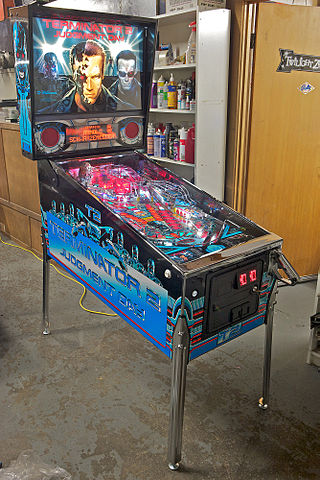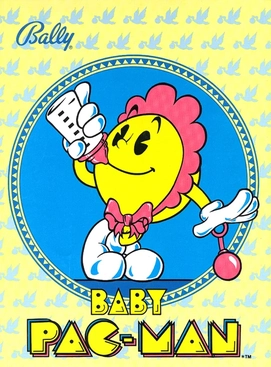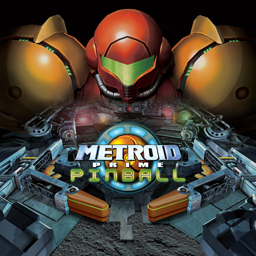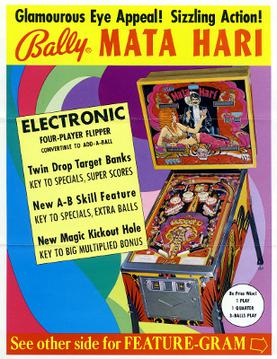
Pinball games are a family of games in which a ball is propelled into a specially designed table where it bounces off various obstacles, scoring points either en route or when it comes to rest. Historically the board was studded with nails called 'pins' and had hollows or pockets which scored points if the ball came to rest in them. Today, pinball is most commonly an arcade game in which the ball is fired into a specially designed cabinet known as a pinball machine, hitting various lights, bumpers, ramps, and other targets depending on its design. The game's object is generally to score as many points as possible by hitting these targets and making various shots with flippers before the ball is lost. Most pinball machines use one ball per turn, and the game ends when the ball(s) from the last turn are lost. The biggest pinball machine manufacturers historically include Bally Manufacturing, Gottlieb, Williams Electronics and Stern Pinball.
Midway Games Inc., known previously as Midway Manufacturing and Bally Midway, and commonly known as simply Midway, was an American video game developer and publisher. Midway's franchises included Mortal Kombat, Rampage, Spy Hunter, NBA Jam, Cruis'n, and NFL Blitz. Midway also acquired the rights to video games that were originally developed by Williams Electronics and Atari Games, such as Defender, Joust, Robotron: 2084, Gauntlet, and the Rush series.

The Rumble Pak is a removable device from Nintendo which provides force feedback while playing video games. Games that support the Rumble Pak cause it to vibrate in select situations, such as when firing a weapon or receiving damage, to immerse the player in the game. Versions of the Rumble Pak are available for the Nintendo 64, the Nintendo DS, and the Nintendo DS Lite. A select few Game Boy Color and Game Boy Advance (GBA) games use a similar technology built into the game cartridge. Force feedback vibration has become a built-in standard feature in almost every home video game console controller since.

WMS Industries, Inc. was an American electronic gaming and amusement manufacturer in Enterprise, Nevada. It was merged into Scientific Games in 2016. WMS's predecessor was the Williams Manufacturing Company, founded in 1943 by Harry E. Williams. However, the company that became WMS Industries was formally founded in 1974 as Williams Electronics, Inc.

Baby Pac-Man is a hybrid maze and pinball game released in arcades by Bally Midway on October 11, 1982, nine months after the release of Ms. Pac-Man. The cabinet consists of a 13-inch video screen seated above a shortened, horizontal pinball table. The combination fits into roughly the same size space as an upright arcade machine. 7,000 units were produced.

Metroid Prime Pinball is a pinball video game themed after the Metroid series. The game uses the graphical style and various story elements from Metroid Prime. It was developed by Fuse Games and published by Nintendo for the Nintendo DS in North America and Australia in 2005, in Japan in 2006, and in Europe in 2007. Metroid Prime Pinball uses the basic mechanics of pinball, along with typical pinball items. New mechanics are introduced, such as wall jumping and the ability to fire weapons. The Nintendo DS's touchscreen can be nudged with a finger to alter the pinball's trajectory while in motion.

Galactic Pinball is a pinball video game for Nintendo's Virtual Boy game console. The game was released on July 21, 1995 in Japan and on August 14, 1995 in the United States. It is set in the Milky Way galaxy, and has players maneuvering a puck around one of four pinball tables available in the game. The Virtual Boy's standard red-and-black color scheme resulted in criticism of this and other games on the platform for causing nausea, headaches, and eye strain. It uses parallax, which allows the game to display three-dimensional effects. It has received a mixed reception; it was praised for its authenticity, while reception to its physics and controls were mixed. It has received criticism for its lack of ambition and originality.

Pinball 2000 was the last pinball hardware and software platform developed by major pinball manufacturer Williams, and was used in the machines Revenge From Mars and Star Wars Episode I before Williams exited the pinball business on October 25, 1999. It is the successor to the Williams Pinball Controller platform.

Jack-Bot is a 1995 pinball game which was designed by Barry Oursler and Larry DeMar, and released by Williams. It is the third game in the Pin-Bot series, following Pin-Bot (1986) and The Machine: Bride of Pin-Bot (1991).
The Williams Pinball Controller (WPC) is an arcade system board platform used for several pinball games designed by Williams and Midway between 1990 and early 1999. It is the successor to their earlier System 11 hardware. It was succeeded by Williams/Midway's Pinball 2000 platform, before Williams left the pinball business in October 1999.

Bally Manufacturing, later renamed Bally Entertainment, was an American company that began as a pinball and slot machine manufacturer, and later expanded into casinos, video games, health clubs, and theme parks. It was acquired by Hilton Hotels in 1996.

Xenon is a 1980 pinball machine designed by Greg Kmiec and released by Bally. The game was not only the first talking pinball table by Bally, but also the first with a female voice.

The Party Zone is a crossover solid-state pinball machine released in 1991 by Midway designed by Dennis Nordman and programmed by Jim Strompolis. It is in a single playfield format and collaborates characters from previous pinball machines. It is the second pinball machine released after the Bally-Midway division was sold, yet still operated under the "Bally" name.
Electro-mechanical games are types of arcade games that operate on a combination of some electronic circuitry and mechanical actions from the player to move items contained within the game's cabinet. Some of these were early light gun games using light-sensitive sensors on targets to register hits, while others were simulation games such as driving games, combat flight simulators and sports games. EM games were popular in amusement arcades from the late 1940s up until the 1970s, serving as alternatives to pinball machines, which had been stigmatized as games of chance during that period. EM games lost popularity in the 1970s, as arcade video games had emerged to replace them in addition to newer pinball machines designed as games of skill.

Mata Hari is a pinball machine created by Bally Manufacturing in 1977 and released in 1978. The theme of the game is based on Dutch exotic dancer, Mata Hari. It was mainly produced using solid-state electronics but also 170 electro-mechanical versions were released. It was the last model manufactured by Bally in two such versions. Approximately 20 sample games were produced with a plastic playfield, instead of the traditional wooden playfield.

Play-Boy is a pinball machine released by Gottlieb in 1932. The game features a card gambling theme. It should not be confused with several other pinball machines with the name Playboy as from Rally Play Company, Bally, Data East and Stern.

Eight Ball Deluxe is a pinball machine designed by George Christian and released by Bally in 1981. The game features a cue sports theme and was so popular that it was produced again in 1984.
Bugs Bunny's Birthday Ball is a 1990 pinball game designed by John Trudeau and Python Anghelo and released by Midway. It is based on Warner Bros.' Looney Tunes and Merrie Melodies series of cartoons. This is the first of only two licensed pinball tables ever to feature the Looney Tunes characters.

An arcade game or coin-op game is a coin-operated entertainment machine typically installed in public businesses such as restaurants, bars and amusement arcades. Most arcade games are presented as primarily games of skill and include arcade video games, pinball machines, electro-mechanical games, redemption games or merchandisers.














